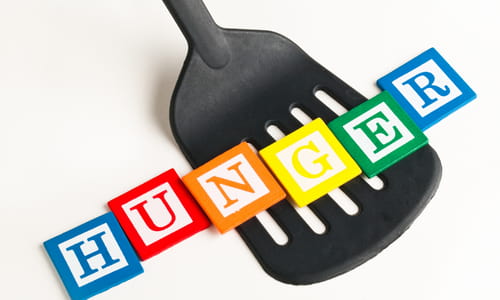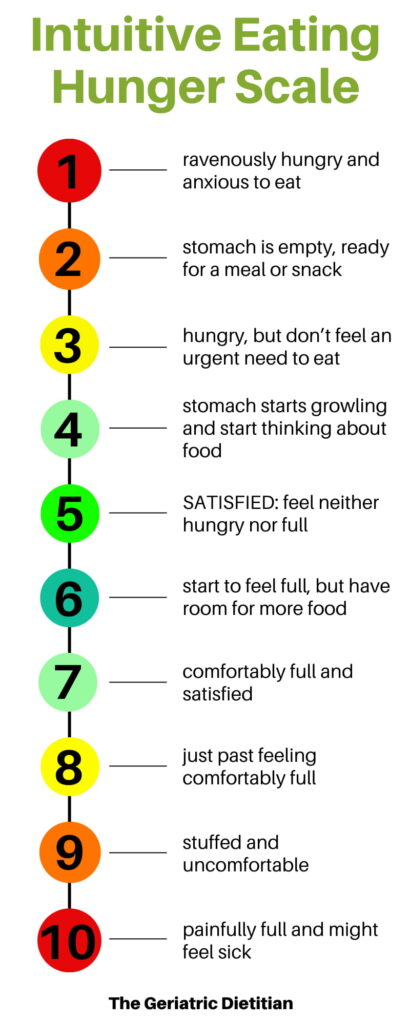Intuitive Eating Hunger Scale: Increasing Intake in Older Adults
“Intuitive Eating Hunger Scale: Increasing Intake in Older Adults” was written by Kourtney Johnson, RD, LD & edited/reviewed by Aly Bouzek, MS, RDN.
It’s no secret that we tend to eat less as we age, and you’ve likely seen this with yourself or loved one(s).
Maybe you just don’t have the capacity to eat as much as you used to without filling up quickly. Or maybe you aren’t interested in foods in general, even ones you used to love.
Luckily there is a handy tool available called the Intuitive Eating Hunger Scale. Read on to learn more about this resource and how it can help increase calorie intake!
Why Appetite Decreases with Age
There are several reasons why our appetite decreases as we age. The one reason is a decrease in physical activity. Less physical activity means that our body isn’t using up the nutrients from our food as quickly.
If these nutrients don’t need to be replenished as often, then our body can send signals of fullness – prompting us to eat less.
Another reason is that our metabolism slows down. Similar to above, this means that our body holds onto calories, protein, fat, carbohydrates, and nutrients that we get from our food and drink.
Holding onto these for longer may give our body the signal that we don’t need to keep replenishing our food stores.
There are also psychological changes that can occur with age, such as depression due to life changes, being diagnosed with an illness, moving somewhere new, or losing a spouse.
These drastic changes may cause us to eat less or to not want to eat.
Additional reasons why our appetite decreases as we age include : diabetes, cancer, congestive heart failure, difficulty swallowing, denture or teeth problems, and medications. These can all impact our food intake.
Some specific medications, such as Paxil and Zoloft (antidepressants), can decrease appetite. Talk with your doctor about your options and let them know if you are needing to gain or maintain your weight. (1)
Identifying Your Hunger Cues
Keeping the above reasons in mind is important when navigating the process of increasing your nutrition intake. However, the Intuitive Eating Hunger Scale might help you notice your hunger cues.
Before we talk about the concept of the Intuitive Eating Hunger Scale, let’s first talk about the definition of Intuitive Eating.
Intuitive Eating uses 10 principles to form a framework based on emotions, self-care, instinct, thought, and action around all foods. (2) Intuitive eating is an evidence-based guide that was created in 1995 by two dietitians: Evelyn Tribole and Elyse Resch. (2)
Here are the 10 principles that make up Intuitive Eating (2):

- Refuse “diet mentality”
- Listen and act on your hunger
- Be at peace with food
- Question the food police
- Feel your fullness
- Be mindful of the satisfaction factor
- Use kindness toward your feelings
- Give your body respect
- Exercise
- Respect your health using gentle nutrition
In short, the framework is a way to tune into your body’s cues and use those signals to make informed decisions about what, when, and how much to eat.
Listening and acting on your hunger, or “Honor[ing] your Hunger,” is the principle which focuses on learning and responding to our hunger cues.
The Intuitive Eating Hunger Scale

The Intuitive Eating Hunger Scale is a useful guide in learning our hunger cues and learning how hungry we actually are.
With numbers ranging from one to ten, it runs the spectrum from extreme hunger to extreme fullness.
Here’s a general guide to what the numbers mean.
1: You’re ravenously hungry and anxious to eat
2: Your stomach is empty, and you’re ready for a satisfying meal or snack
3: You’re hungry, but don’t feel an urgent need to eat yet
4: Your stomach is starting to growl, and you start thinking about food
5: You feel neither hungry nor full
6: You’re starting to feel full, but still have room for more food
7: You’re comfortably full and satisfied
8: You’re just past feeling comfortably full
9: You are stuffed and uncomfortable, and might need to wear loose clothing
10: You’re painfully full and might even feel sick
The Hunger Scale is not a “hunger/fullness diet” to follow but rather a guide. It is generally recommended to start eating when you have feelings correlating with a 3 and to stop eating at feelings of a 7.
This is not because it’s “bad” to eat when you’re not hungry or “good” to stop before you feel extremely full, but because it’s a way to avoid uncomfortable hunger and uncomfortable fullness.
There is no morality associated with how hungry or full someone is! (3)
Even if you don’t notice hunger cues right now, knowing the descriptions on the Hunger Scale might help you notice new hunger signs.
Using the Intuitive Eating Hunger Scale: Subtle Hunger Cues
Contrary to what we usually think, you don’t need to have a growling stomach to be hungry. There are a variety of cues that are more subtle, including (3):
- Headache
- Fatigue
- Shakiness
- Dizziness
- Confusion
- Increased thoughts about food
If you notice any of these cues regularly, then try eating something in response. This can help you determine the underlying cause of the signals that you’re experiencing.
Intuitive Eating Hunger Scale: Types of Hunger
When we think of hunger, we tend to picture a growling stomach or someone who is “hangry.” However, there are four different types of hunger which make up all the reasons why we might eat.
They are:
- Biological Hunger
- Taste Hunger
- Practical Hunger
- Emotional Hunger
Biological Hunger

The first kind of hunger is the most obvious one.
Biological hunger is when we experience physical signs of hunger such as a growling stomach, irritability, exhaustion, and shakiness.
Everyone experiences biological hunger, because everyone needs food to survive!
It’s our body’s way of telling us that it needs more nutrients to function.
Taste Hunger

Taste hunger is when we eat in response to the flavor of food.
We often aren’t biologically hungry when this occurs.
Think of when we eat dessert.
We might be full after a meal, but sometimes we manage to have room for something sweet (and maybe even a second helping of dessert!).
Practical Hunger

Practical hunger is the idea that we eat to avoid extreme hunger later.
For example: you have a few back-to-back appointments over the next two hours and you know you’ll be starving by the end.
So, you might eat something before they start (even if you aren’t biologically hungry) so that you aren’t ravenously starving during your appointments.
Emotional Hunger

Finally, emotional hunger is when we eat in response to situations and emotions.
Food is soothing and can make us feel better temporarily, so it is not bad to use it as a coping tool.
Though it is important to understand that food does not fix the root of the problem, and that it’s best to have more than one coping mechanism available.
Keep in mind that there isn’t one form of hunger that’s better than another. If you are struggling to notice signs of biological hunger, then try eating for taste or make sure that you’re meeting your nutrient needs. (3)
Recommendations for Meeting Nutrient Needs for Older Adults
When we don’t notice hunger cues, it can be difficult for us to eat enough throughout the day. Fortunately, there are general guidelines to make this easier.
First, eating every three to five hours can help us eat frequently throughout the day. This provides sustainable energy and is also a way to “train” our body to get used to an eating pattern.
When that pattern is off, our body is likely to send hunger signals indicating that it’s time to eat to stay on schedule.
If you can easily go hours without eating, then try setting an alarm to remind you when it’s time to eat again.
Eating smaller, more frequent meals is generally better than eating fewer large ones. Again, eating more frequently ensures sustained energy during the day, but also decreases the likelihood of eating to uncomfortable fullness.
This is because when we begin eating while ravenously hungry, we are likely to eat quickly without paying attention to emerging fullness. Then, before we know it, we are uncomfortably full.
But, when we start eating at a point where we are moderately hungry, it’s much easier to notice that we are getting fuller as we eat.
Remember that food isn’t the only way to provide your body with nutrition. Smoothies, shakes, and other drinks are great options as well and are easy to sip on throughout the day. They are also ideal if you have dental problems or other texture limitations.
You might also consider your eating environment. Eating with other people in a calm, inviting setting is ideal if it’s an option. (1)
Wrapping Up the Intuitive Eating Hunger Scale
Learning hunger cues takes time and practice. Being patient with the process is important!
There are lots of reasons why you may be eating less as you age. Using a tool like the Intuitive Eating Hunger Scale can help you tune into your body’s signals to determine your level of hunger.
If you are having trouble identifying your hunger cues, then try eating every three to five hours with others.
Resources:
- Bareuther CM. Dwindling appetites. Aging Well. 2010;3(3):32. Accessed August 12, 2022. https://www.todaysgeriatricmedicine.com/archive/082510p32.shtml.
- Tribole E. Definition of Intuitive Eating. The Original Intuitive Eating Pros. Published July 17, 2019. Accessed August 12, 2022. https://www.intuitiveeating.org/definition-of-intuitive-eating/.
- Tribole E, Resch E. Intuitive Eating: A revolutionary anti-diet approach. 4th edition. St. Martin’s Essentials; 2020.
